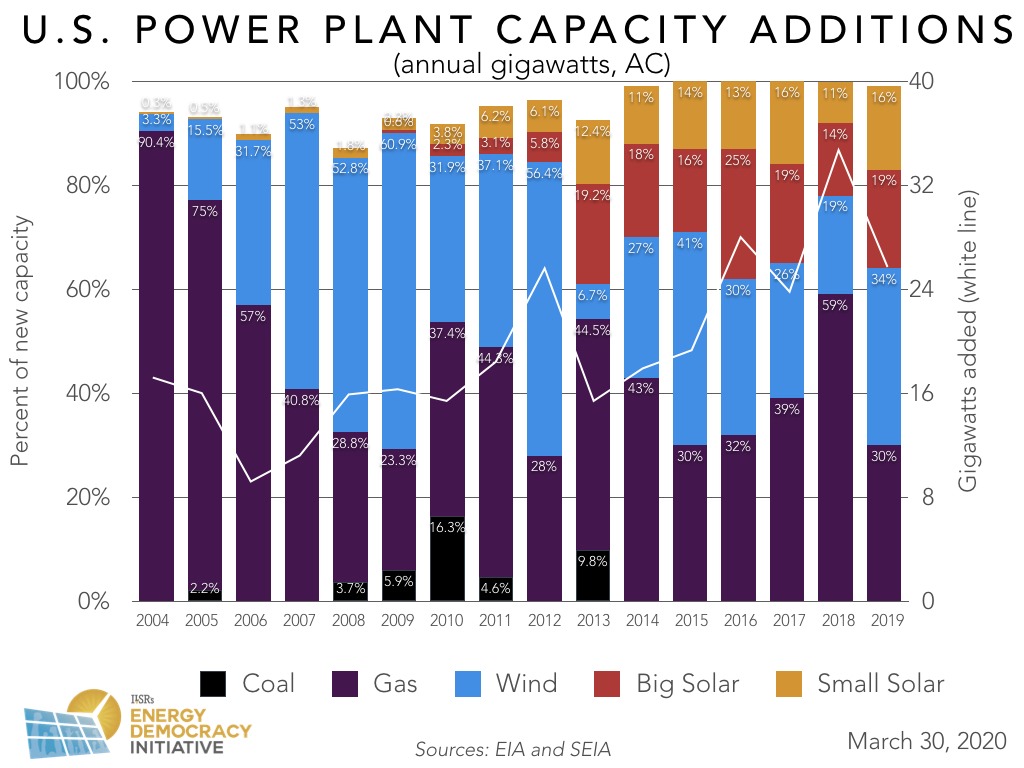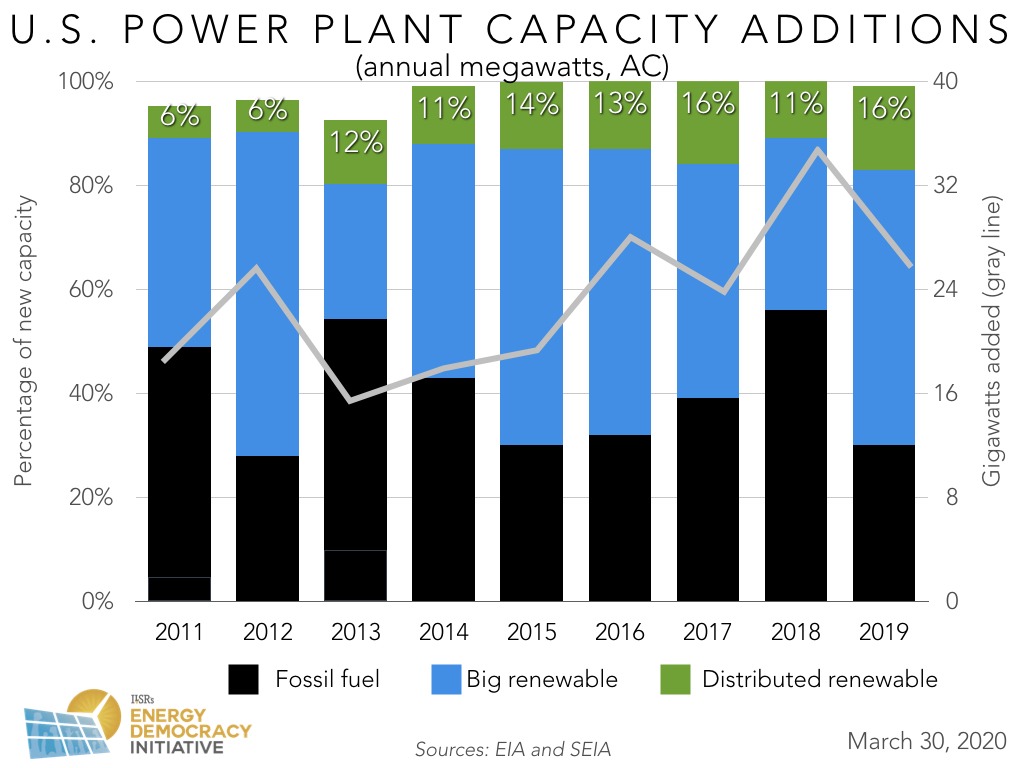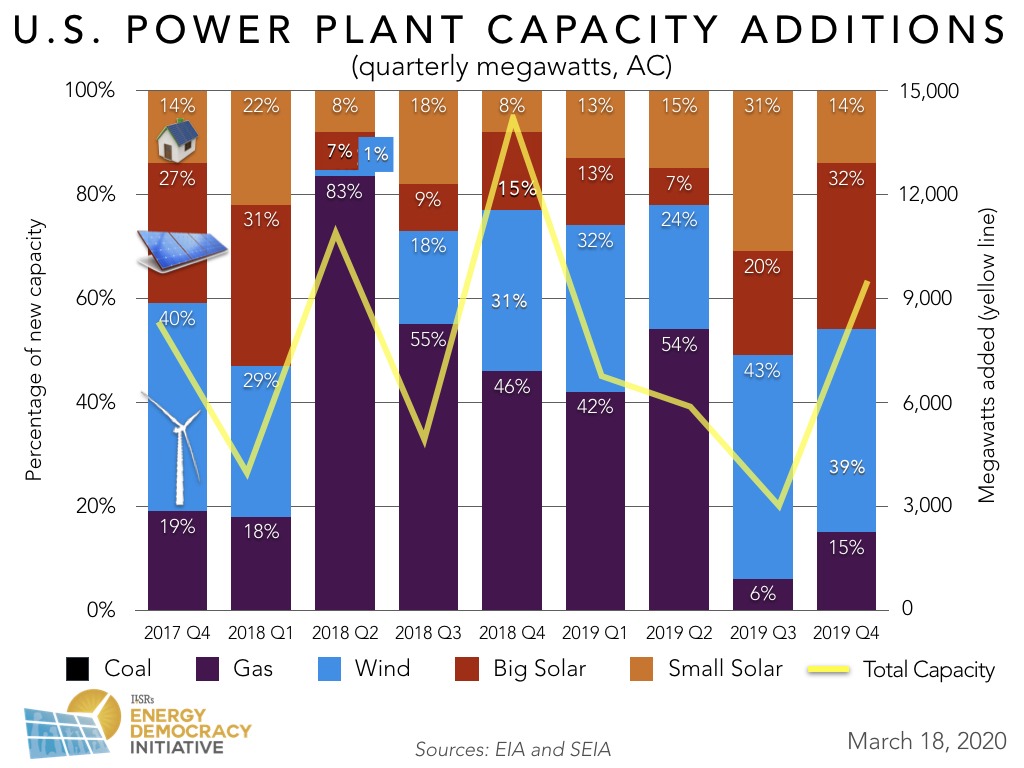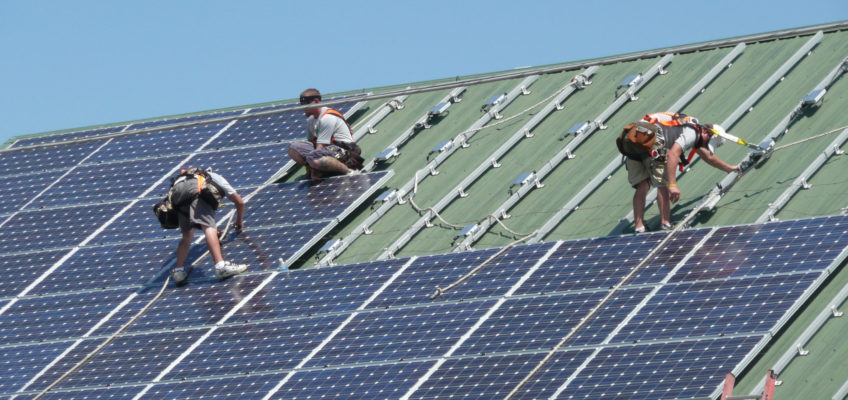Each year, federal agencies track new power plant construction to document how we produce energy. For years, they overlooked the power that customers generated for themselves from rooftop solar. This annual and quarterly report compiles data from the U.S. Energy Information Administration and the Solar Energy Industries Association to illustrate the growing influence of renewable energy, both large-scale and distributed, in the U.S. energy portfolio.
As coal plants retire and new renewable generation becomes more cost effective than existing gas-fired generation, electric generation capacity continues to grow. Total power generation capacity followed its upward trajectory in 2019. Although the year’s added generation capacity of 25.7 gigawatts is not the highest on record, in the last 15 years it is second only to 2018’s total of 34.7 gigawatts.
Below are updated illustrations and analysis of national data on new power plant capacity, disaggregated by energy source. We present annual results from 2019 first, followed by more detail from the fourth quarter of last year, as part of our regular quarterly reporting.
Annual New Power Plant Capacity — 2019


A Strong Year for Wind and Small Solar
2019 was our greatest recorded year for new wind generation, with 8,859 MW of capacity added. This was to be the last year of the federal production tax credit for wind, however, legislators renewed the credit in December 2019 for another year. Considering the wind installation boom at year end, another may be coming as developers expect the renewal to expire at the end of 2020.
This was also distributed solar’s biggest year. The federal solar tax credit decreases from 30% in 2019 to 26% in 2020, so developers were driven to get the 2019 rebate. By the end of the year, individuals and communities had installed enough small solar projects to generate 4,080 MW of power. This figure landed distributed solar just shy of its large-scale counterpart, which saw 4,979 MW of added solar capacity this year under the same tax credit rate.
Three states passed legislation to expand their community solar programs in 2019, while the 18 states with shared renewables legislation continued to develop their programs. In these states, everyone can receive the benefits of distributed solar — not just those with the means to install solar on their own roof.
Western wildfires, and planned power outages to prevent the fires, prompted many discussions on the desperate need for distributed energy. Although the rooftop solar industry in California is booming, without storage or local microgrids, residents are unable to use the energy they are producing in the case of an outage.
To visualize the growth of community solar programs state by state, see our National Community Solar Programs Tracker.
Large Solar is Stagnant, Gas Drops to a Four Year Low
While new wind and small solar generation capacity peaked in 2019, large solar and gas faltered. This year, only 4,979 MW of large solar capacity came online. This figure just barely exceeds 2018’s total of 4,922 MW. In fact, the biggest year for new large solar capacity was in 2016. Could 2020 be the year that distributed solar overtakes utility-scale solar?
2019 was the weakest year for new gas capacity, with only 7,830 MW added. Annual new gas capacity has not been this low since 2015.
Will this year’s drop in new gas capacity be the beginning of a trend? Read this Rocky Mountain Institute Report on why gas is no longer a good deal for power producers.
A Look into 2020
If the established trends continue, renewable electricity generation should steadily grow in 2020. However, events like the coronavirus epidemic and major elections have the ability to shake these trends — few can predict just how much the Coronavirus epidemic will impact the power sector. At the very least, as many with the ability to are staying home, electricity demand has been dropping.
Although much of 2020 is clouded in uncertainty, the great momentum of clean, distributed energy has generated a hope that may cut through the haze.
Check out our other summary reports of 2019, including the 2020 Community Power Scorecard and Three Big Energy Stories from 2019 with 2020 Implications.
Quarterly Power Plant Capacity Update — 2019 Q4
After a year-long downturn, new power generation capacity swelled in the fourth quarter of 2019. Gas, wind, large solar, and small solar all had greater added generation capacity in quarter four as compared to last quarter. While new small solar capacity experienced modest gains this quarter, large solar made a strong showing. Wind, the greatest proportion of new generation this quarter, nearly tripled from last quarter. New gas capacity rebounded from its low in quarter three, which was its smallest new quarterly capacity in years. Despite the eightfold increase of gas, renewables maintained their strong majority of new power generation.
In the chart below, we illustrate the past two years of new power plant capacity in the U.S., disaggregated by energy source on a quarterly basis.

Large Solar and Wind Surge in Final Push of 2019
The fourth quarter was strongest of 2019 for each type of energy generation, but wind and large solar came out on top.
Large solar took the largest percentage of new capacity that it has taken since the third quarter of 2016. Solar developers rushed to take advantage of the federal solar tax credit: a rebate of 30% of the system cost. This credit, available for commercial and residential solar, drops to 26% of system cost in 2020. The credit incentivizes large solar, but has been less useful for distributed solar. Residential customers can install their own system and use the tax credit, but community shared solar has struggled to use it to its advantage.
Wind taking the largest percentage of new generation capacity this quarter comes as no surprise. For the last five years (every year that we have tracked), the fourth quarter has been when the most wind generation has come online. In December 2019, federal legislators passed a one year extension period for wind construction seeking the federal tax credit. This sets up wind generation for continued growth in 2020, but does not provide certainty beyond 2021.
Interested in earlier trends and analysis of new power plant capacity? Check out our archive, illustrating how electricity generation has changed in previous quarters and years.
This article originally posted at ilsr.org. For timely updates, follow John Farrell on Twitter or get the Energy Democracy weekly update.
Featured Photo Credit: seagul via Pixabay





